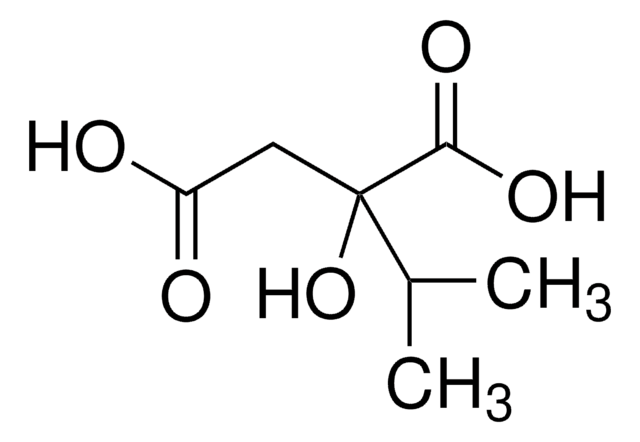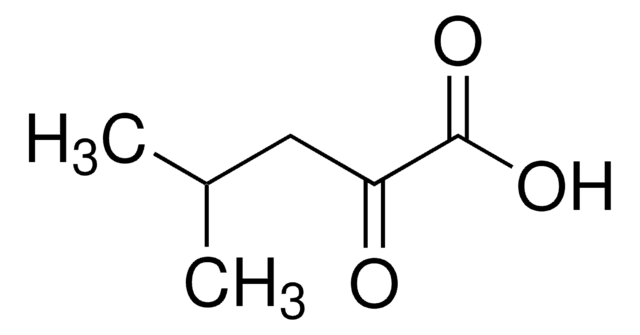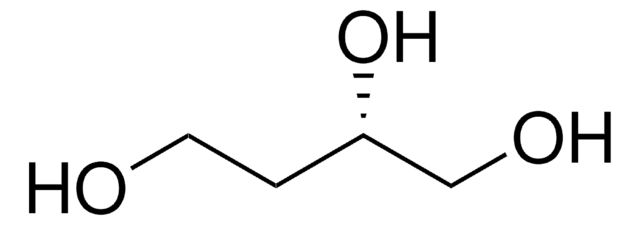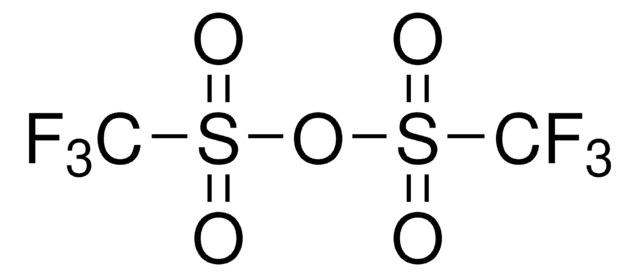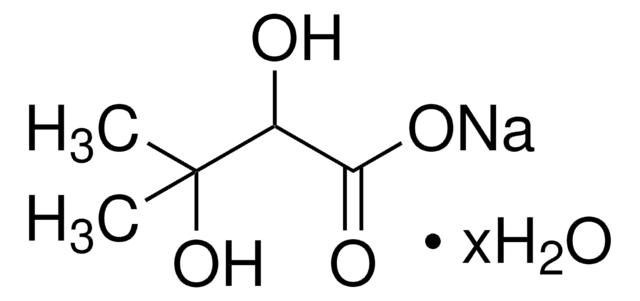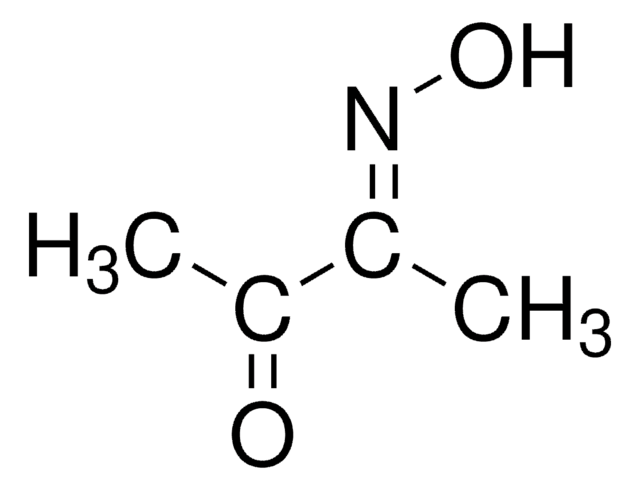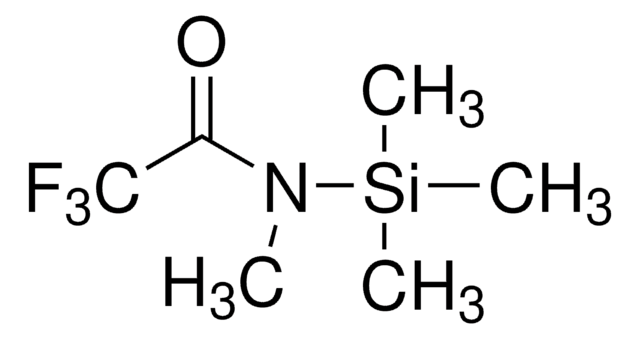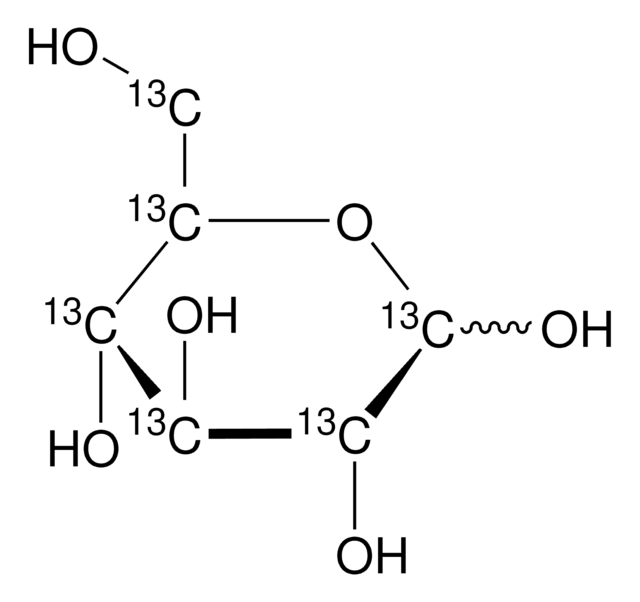333115
2-Isopropylmalic acid
98%
Sinónimos:
2-Hydroxy-2-isopropylsuccinic acid
Iniciar sesiónpara Ver la Fijación de precios por contrato y de la organización
About This Item
Fórmula lineal:
HO2CCH2C[CH(CH3)2](OH)CO2H
Número de CAS:
Peso molecular:
176.17
Número MDL:
Código UNSPSC:
12352100
ID de la sustancia en PubChem:
NACRES:
NA.22
Productos recomendados
Nivel de calidad
Ensayo
98%
mp
144-146 °C (lit.)
grupo funcional
carboxylic acid
hydroxyl
cadena SMILES
CC(C)C(O)(CC(O)=O)C(O)=O
InChI
1S/C7H12O5/c1-4(2)7(12,6(10)11)3-5(8)9/h4,12H,3H2,1-2H3,(H,8,9)(H,10,11)
Clave InChI
BITYXLXUCSKTJS-UHFFFAOYSA-N
¿Está buscando productos similares? Visita Guía de comparación de productos
Categorías relacionadas
Descripción general
2-Isopropylmalic acid is an intermediate formed during leucine biosynthesis. Budding yeast Saccharomyces cerevisiae secrets 2-isopropylmalic acid and helps in reduction of aluminum toxicity by forming chelate with Al ions, thereby preventing them from entering the cells.
Aplicación
2-Isopropylmalic acid was employed as an internal standard in diagnostic model for pancreatic cancer using GC/MS-based human serum metabolomics.
Código de clase de almacenamiento
11 - Combustible Solids
Clase de riesgo para el agua (WGK)
WGK 3
Punto de inflamabilidad (°F)
Not applicable
Punto de inflamabilidad (°C)
Not applicable
Equipo de protección personal
dust mask type N95 (US), Eyeshields, Gloves
Elija entre una de las versiones más recientes:
¿Ya tiene este producto?
Encuentre la documentación para los productos que ha comprado recientemente en la Biblioteca de documentos.
Los clientes también vieron
Luiz Pedro S de Carvalho et al.
Biochemistry, 48(9), 1996-2004 (2009-01-27)
The enzyme alpha-isopropylmalate synthase from Mycobacterium tuberculosis (MtIPMS) has been identified as a possible target for the design of new antitubercular therapeutics. Recently, it was shown that MtIPMS is subject to slow-onset, feedback inhibition by l-leucine, the first instance of
Taisuke Suzuki et al.
Biological trace element research, 120(1-3), 257-263 (2007-10-06)
The budding yeast Saccharomyces cerevisiae secretes 2-isopropylmalic acid (2-iPMA), an intermediate in leucine biosynthesis. Because 2-iPMA binds Al(III) in the culture medium, it is thought to reduce toxicity by Al(III). The effects of 2-iPMA and malic acid (MA) on Al
Carlo M T Marobbio et al.
The Journal of biological chemistry, 283(42), 28445-28453 (2008-08-07)
In Saccharomyces cerevisiae, alpha-isopropylmalate (alpha-IPM), which is produced in mitochondria, must be exported to the cytosol where it is required for leucine biosynthesis. Recombinant and reconstituted mitochondrial oxalacetate carrier (Oac1p) efficiently transported alpha-IPM in addition to its known substrates oxalacetate
Y Hu et al.
Molecular and cellular biology, 15(1), 52-57 (1995-01-01)
The Leu3 protein of Saccharomyces cerevisiae has been shown to be a transcriptional regulator of genes encoding enzymes of the branched-chain amino acid biosynthetic pathways. Leu3 binds to upstream activating sequences (UASLEU) found in the promoters of LEU1, LEU2, LEU4
D Armaleo et al.
Molecular & general genetics : MGG, 200(2), 346-349 (1985-01-01)
The leu-3/alpha-IPM (alpha-isopropylmalate) regulatory system, previously shown to control several genes of leucine, isoleucine, valine, and histidine biosynthesis, appears likely to be involved also in the regulation of overall RNA and protein synthesis in Neurospora. Upon addition of alpha-IPM the
Nuestro equipo de científicos tiene experiencia en todas las áreas de investigación: Ciencias de la vida, Ciencia de los materiales, Síntesis química, Cromatografía, Analítica y muchas otras.
Póngase en contacto con el Servicio técnico
